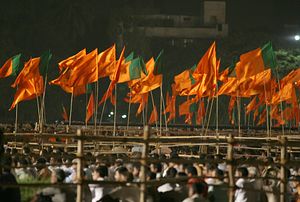At the end of March, India’s ruling Bharatiya Janata Party (BJP) asserted that it had broken a new record. According to the BJP, as a result of a recruitment drive that concluded at the end of March, the party became the world’s largest, surpassing the Communist Party of China (CCP).
The BJP’s stated goal was to have over 100 million members by March 31. By Sunday, March 29, the party claimed to have over 88 million members, at least two to three million more than the CCP. Narendra Modi, India’s BJP prime minister, praised Amit Shah, president of the BJP, for its successful membership drive. Speaking at a party gathering, Modi said that “it is the party which is important and the government is only a tool to achieve our objective.” Modi also added that the party’s new record strengthened the self-confidence of the party by proving that voters were becoming members of the party and the BJP’s victory in national elections in 2014 were not a fluke.
This comes at a time when it is vital for the BJP to shore up its support, especially after the overwhelming victory of one of its rivals, the Aam Aadmi Party (AAP), in Delhi’s February Assembly Elections. More importantly, the BJP needs to focus on upcoming elections in the important, populous Hindi-heartland states of Bihar and Uttar Pradesh. Recent developments in Bihar, which will hold elections later this year, have complicated things for the BJP, which did well in 2014’s national elections in that state.
The strength of the BJP has spurred six opposition parties in Bihar to begin the process of merging. The umbrella term for these parties is the Janata Parivar (Janata family) due to the fact that many of these parties are offshoots of the erstwhile Janata Dal party. The merger of Bihar’s six parties is making the BJP nervous, as it was counting on opposition voters being split in order to enable it to emerge as the largest party in Bihar’s Legislative Assembly. In order to win in Bihar and prevent the example of merging opposition parties from catching on, the BJP must try to keep the factitious opposition split (which would not be too hard to accomplish) or beat the combined opposition. Thus, the logic of the BJP’s membership drive is to enable it to try to win against a combined opposition in states like Bihar, among others.
There’s much skepticism, however, over the BJP’s membership figures. Many individuals claimed that they were registered as members of the BJP without their consent. According to a BJP membership policy, calling the party — even without getting a response — could also lead to membership, meaning that many people who dialed a wrong number could have been registered as BJP members. This led the opposition Congress Party to mockingly dub the BJP the “missed call party.”
Nonetheless, there is no doubt that the BJP has grown enormously since it came to power last May. The BJP has used its technological edge over other Indian parties to recruit new members through Twitter and Facebook. Additionally, the party has used phone drives to gather members. The BJP has also sent local workers to directly connect with the poor and uneducated, rather than just relying on mass rallies and loyal bases, like other parties.
We’ll have to wait until the next election to see how many of the new BJP members will be loyal to the BJP; Indian voters are notoriously fickle. Nonetheless, it is clear that the BJP has a large and expanding party base, one that is definitely more loyal and sizable than any other party in India.

































